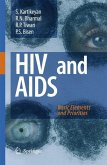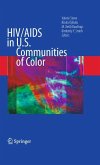More people in communities of color are contracting, living with, and being treated for HIV/AIDS than ever before. In 2005, 71% of new AIDS cases were diagnosed in people of color. The rate of HIV infection in the African-American community alone has increased from 25% of total cases diagnosed in 1985 to 50% in 2005. Latinos similarly comprise a disproportionate segment of the AIDS epidemic: though they make up only 14% of the U.S. population, 20% of AIDS cases diagnosed in 2004 were Latino/a.
Though the number of racial and ethnic minority HIV/AIDS cases continues to grow, the health care community has been unable to adequately meet the unique medical needs of these populations. African-American, Latino/Latina, and other patients of color are less likely to seek medical care, have sufficient access to the health care system, or receive the drugs they need for as long as they need them.
HIV/AIDS in Minority Communities acknowledges the prevalence of HIV/AIDS within minority communities in the U.S. and strives to educate physicians about the barriers to treatment that exist for minority patients. By analyzing the main causes of treatment failure and promoting respect for individual and cultural values, this book effectively teaches readers to provide responsive, patient-centered care and devise preventive strategies for minority communities. Comprehensive chapters contributed by physicians with extensive experience dealing with HIV/AIDS in minority communities cover issues as far-reaching as: anti-retroviral therapy; dermatologic manifestations and co-morbidities of the disease in patients of color; unique risks to women and MSMs of color; participation of minority cases in HIV research; and substance abuse and mental health issues.
Though the number of racial and ethnic minority HIV/AIDS cases continues to grow, the health care community has been unable to adequately meet the unique medical needs of these populations. African-American, Latino/Latina, and other patients of color are less likely to seek medical care, have sufficient access to the health care system, or receive the drugs they need for as long as they need them.
HIV/AIDS in Minority Communities acknowledges the prevalence of HIV/AIDS within minority communities in the U.S. and strives to educate physicians about the barriers to treatment that exist for minority patients. By analyzing the main causes of treatment failure and promoting respect for individual and cultural values, this book effectively teaches readers to provide responsive, patient-centered care and devise preventive strategies for minority communities. Comprehensive chapters contributed by physicians with extensive experience dealing with HIV/AIDS in minority communities cover issues as far-reaching as: anti-retroviral therapy; dermatologic manifestations and co-morbidities of the disease in patients of color; unique risks to women and MSMs of color; participation of minority cases in HIV research; and substance abuse and mental health issues.
From the reviews:
"This collection provides an overview of the behavioral and clinical aspects of the HIV/AIDS epidemic in African American and Latino populations. ... The contributors to this collection are mostly experts on clinical and epidemiological aspects of HIV/AIDS. ... According to the authors, the book is ideal for medical trainees and mental health providers ... . This is a unique and needed guide to HIV/AIDS in African American and Latino populations." (Jesus Ramirez-Valles, Doody's Review Service, October, 2009)
"Valerie Stone and colleagues have gathered a series of presentations that attempt to address some of the unique issues in managing human immunodeficiency (HIV) in the Latino, African American, Asian/Pacific Islander, American Indian, and Alaska Native populations. ... One of the major themes running throughout HIV/AIDS in U.S. Communities of Color is that of cultural competence ... . The call for cultural competence is needed not only for the minorities addressed in this book but for the education of all HIV caregivers and researchers." (Thomas Monson, Journal of the American Medical Association, Vol. 303 (11), March, 2010)
"This collection provides an overview of the behavioral and clinical aspects of the HIV/AIDS epidemic in African American and Latino populations. ... The contributors to this collection are mostly experts on clinical and epidemiological aspects of HIV/AIDS. ... According to the authors, the book is ideal for medical trainees and mental health providers ... . This is a unique and needed guide to HIV/AIDS in African American and Latino populations." (Jesus Ramirez-Valles, Doody's Review Service, October, 2009)
"Valerie Stone and colleagues have gathered a series of presentations that attempt to address some of the unique issues in managing human immunodeficiency (HIV) in the Latino, African American, Asian/Pacific Islander, American Indian, and Alaska Native populations. ... One of the major themes running throughout HIV/AIDS in U.S. Communities of Color is that of cultural competence ... . The call for cultural competence is needed not only for the minorities addressed in this book but for the education of all HIV caregivers and researchers." (Thomas Monson, Journal of the American Medical Association, Vol. 303 (11), March, 2010)








